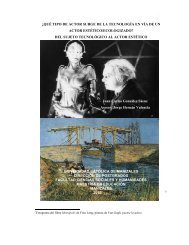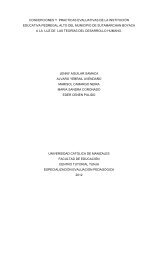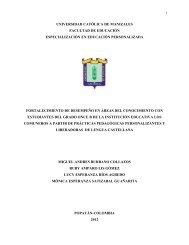Fabio Leon Yepes Londono.pdf - Universidad Católica de Manizales
Fabio Leon Yepes Londono.pdf - Universidad Católica de Manizales
Fabio Leon Yepes Londono.pdf - Universidad Católica de Manizales
Create successful ePaper yourself
Turn your PDF publications into a flip-book with our unique Google optimized e-Paper software.
ABSTRACT<br />
LA LA COMPLEJIDAD COMPLEJIDAD DE DE LA LA IMAGEN IMAGEN<br />
IMAGEN<br />
Starting from the complexity of the image, as a possibility of the human<br />
condition, we begin from thematic no<strong>de</strong>s of complexity, humanization and<br />
relation with the other, for this we start with the a radical question – Which<br />
complex phenomena of the image must be approached from a changing and<br />
facilitating sense, of interpretation of himself as a conceptual basis of<br />
un<strong>de</strong>rstanding the other?<br />
Currently the image fa<strong>de</strong>s in all the aspects, from the object until its own<br />
i<strong>de</strong>ntity. Defining the image becomes a difficult task with overpasses the<br />
support limits to be observed, it is to look for the same representation and<br />
perception that make the subject of you and the others. The image is always an<br />
educated witness of all the things that are interesting to the society, it is where<br />
all the current glances are lived and discussed, the groups and the thought of<br />
the subject, suppose a pattern in the way, be it, that we travel by foot or on a<br />
vehicle.<br />
The image is the result of a reflection between the subject and reality,<br />
between the properties of the objects and the nature and intention of the<br />
observer; the action of looking is an active operation of extracting information<br />
from the environment, through the successive glances to the scene or image<br />
that compose the globalization.<br />
In this sense a path is set through the triad, from the aesthetic, pedagogy and<br />
humanity, to carry out the human condition as a base of the cultural processes,<br />
from there it dimension and its role in the contemporary world can be seen<br />
acting on the signs modifying the senses. To help in the analysis of these<br />
elements, we will use the sand clock as a kind of metaphor.<br />
This metaphor permits to make a comparison between the sand clock and<br />
man, since it contains expressions and symbolisms that are found in a society,<br />
which is in constant <strong>de</strong>velopment and evolution, in which it is necessary to give<br />
a new glance of the image from the aesthetics, sensibility and norms that<br />
directly affects the human being from its relations with himself and the others.<br />
UNIVERSIDAD CATOLICA DE MANIZALES<br />
7








